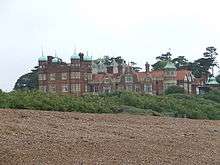Bawdsey Manor

Bawdsey Manor stands at a prominent position at the mouth of the River Deben close to the village of Bawdsey in Suffolk, England, about 74 miles (119 km) northeast of London.[1] Built in 1886, it was enlarged in 1895 as the principal residence of Sir William Cuthbert Quilter. Requisitioned by the Devonshire Regiment during World War I and having been returned to the Quilter family after the war, it was purchased by the Air Ministry for £24,000[2] in 1936 to establish a new research station for developing the Chain Home RDF (radar) system.[3] RAF Bawdsey was a base through the Cold War until the 1990s. The manor is now used for weddings and courses,[4] and has a small museum in the Radar Transmitter Block.[5]
History
Quilter period: 1886 to 1936
Bawdsey Manor was built in 1886 and enlarged in 1895[3] by William Quilter who was an art collector, one of the founders of the National Telephone Company and was Liberal/Liberal Unionist Member of Parliament for Sudbury.[6] He established a steam-powered chain ferry across the River Deben in 1894 to access the nearest railway station at Felixstowe. It was known as the Bawdsey Ferry and ran until 1931.[7] The ferry now operates using a motor-launch at weekends during the summer.
Maude Marion Quilter (born about 1868) of Bawdsey Manor, daughter of Sir William Quilter, 1st Baronet, married Frederick Denny in 1888 and later had Horwood House as her country residence. It was at Bawdsey Manor that she knew of Harry Thrower, the father of Percy Thrower, as he was a gardener there, it being his first gardening position. When Maude wanted a head gardener at Horwood House, she recruited Harry and he remained there the rest of his life.
RAF Base: 1936 to 1990
In February 1936 research scientists, including Robert Watson-Watt moved into the Manor to begin research and development into radar for practical military use[8] and it became known as RAF Bawdsey. Stables and outbuildings were converted into workshops and 240 ft wooden receiver towers and 360 ft steel transmitter towers were built. Bawdsey was the first Chain Home Radar Station. By the outbreak of World War II a chain of radar stations was in place around the coast of Britain.[2] Bawdsey Manor continued as an RAF base through the Cold War and Bloodhound Missiles were sited on the cliffs until the Bloodhound force ceased operations in 1990, when all the missiles were withdrawn to RAF West Raynham. RAF Bawdsey was closed in 1991.[2]
Since 1990
The Manor, grounds and associated buildings are now used as a boarding and day school for children from ages 11 to 18, Alexanders College.
The Transmitter Block is a museum, with limited opening hours, and was featured in the BBC Restoration programme.[5] The exhibit is known as "The Magic Ear", and is operated by the Bawdsey Radar Group.
See also
External links
| Wikimedia Commons has media related to Bawdsey Manor. |
References
- ↑ "Pictures of Bawdsey Manor". Pictures of England.com. 2001–2009. Retrieved 15 August 2009.
- 1 2 3 "History of Bawdsey Radar Station". Archived from the original on 28 December 2007. Retrieved 2007-12-30.
- 1 2 "RAF Bawdsey Chain Home Radar Station". Retrieved 2007-12-30.
- ↑ "Bawdey Manor". Archived from the original on 11 December 2007. Retrieved 2007-12-30.
- 1 2 "Restoration: Bawdsey transmitter block". 2004-06-01. Retrieved 2007-12-30.
- ↑ "Baronetage". Retrieved 2007-12-30.
- ↑ "Felixstowe Ferry-Bawdsey". Archived from the original on 3 February 2008. Retrieved 2007-12-30.
- ↑ "Contact Magazine". University of Dundee - Press Office. March 1998. Retrieved 15 August 2009.
Coordinates: 51°59′18″N 1°23′54″E / 51.988313°N 1.398204°E